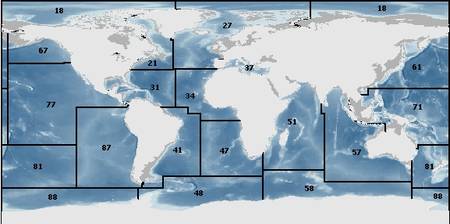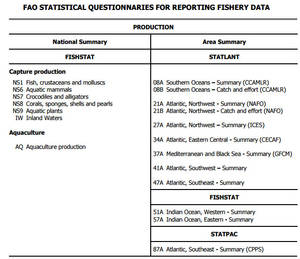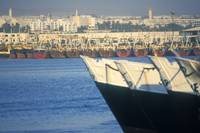Achievements of the Coordinating Working Party
Standardizing statistical reporting systems
By integrating and coordinating the statistical programmes used by different organizations, the CWP has standardized statistical reporting systems, resulting in the use of a reduced number of FAO questionnaires. This work has led to an improvement in both the quantity and quality of fishery statistics and has facilitated the timely submission of statistical data from national offices to participating organizations. Although the CWP confined its attention to the development and improvement of Atlantic fishery statistics up until 1995, its procedures and concepts have served as models for fishing areas in other oceans.
Catch and effort data
Catch and effort data have been collected for different major fishing areas using questionnaires which apply common classifications and definitions. The questionnaires are designed in a unified style, but tailored to the particular needs of the relevant regional fisheries organization. This reduces the burden on countries completing questionnaires for more than one major fishing area, by applying common systems and standards. For example, conventions regarding the reporting of catch by country in relation to joint-venture fishing operations or vessel chartering can be applied universally.
Provide harmonized criteria
The CWP has provided guidance on the attribution of nationality to catch data and always applied the principle that the "flag of the vessel performing the essential part of the operation catching the fish should be considered the paramount indication of the nationality [to be] assigned to the catch data". The formulation of criteria for assigning nationality were further refined at the Eighteenth Session of CWP and this process was described in a paper subsequently published by FAO.
The catch and effort questionnaires developed by the CWP, originally called STANA and now called STATLANT, are sent to the relevant national authorities by FAO on behalf of the regional fishery organizations. The CWP has made a major contribution to the specification of measures of fishing effort by gear type.
More...
More...
STATLANT A questionnaires are used for reporting annual nominal catch by species and by statistical sub-area, division or subdivision. STATLANT B questionnaires are used for reporting fishing effort by month, vessel size class, gear and statistical sub-area, division or subdivision, in addition to associated catch by species. In some cases the species sought (target species) are also specified.
STATLANT A and B questionnaires have been used by CCAMLR to collate statistics for major fishing areas 48, 58 and 88 (Southern Oceans), by NAFO for area 21 (Northwest Atlantic), by ICES for area 27 (Northeast Atlantic), by CECAF for area 34 (Eastern Central Atlantic), and by GFCM for area 37 (Mediterranean and Black Sea). Despite the fact that the Regional Fisheries Advisory Commission for the Southwest Atlantic (CARPAS) has not convened a meeting since 1974 and ICSEAF has ceased to function, FAO still sends STATLANT 41A, 47A and 47B questionnaires and stores the returns; however, not much use is being made of these now and the CWP will need to consider whether continuation of the STATLANT 41 and 47 reporting systems can be justified
Eurostat requested submissions of catch statistics from EU Member States on STATLANT questionnaires (or in compatible electronic formats) and these questionnaires have been translated into EU legislation. FAO also sends out a STATPAC 87A questionnaire which is similar to the STATLANT A questionnaires but for the Southeast Pacific, in conjunction with the Comisión Permanente del Pacífico Sur.
Changes in the nature of fisheries and in the needs of users of fishery statistics require frequent reviews of statistical systems. For example, the STATLANT B reporting system no longer provides appropriate data for stock assessment purposes in some areas: it has been terminated for the Northeast Atlantic by ICES, for the Mediterranean by GFCM and for the Eastern Central Atlantic by CECAF.
The FishStat reporting system is used by FAO to collate global statistics on catch and production from over 240 countries for over 1 000 species of aquatic organisms of significant commercial importance in all inland and marine fishing areas. FishSTAT is run in parallel with the STATLANT system in areas where the latter is operated. Reconciling the catch data held by the regional fishery organizations with the FAO FISHSTAT data is therefore another issue with which the CWP has been confronted. At its Eighteenth Session the CWP called for a prototype integrated database of Atlantic catch data incorporating selected data from FAO, ICES, NAFO, ICCAT and CCAMLR to provide comprehensive coverage with as much geographical resolution as possible, and without overlaps. This first prototype of an integrated Atlantic catch database was developed in 2000.
At its Fifteenth Session the CWP considered the problems associated with the collection of fishery statistics but accentuated by the high seas (e.g. flags of convenience, trans-shipments, landings into foreign ports, processing at sea) and noted the particular need for special effort and collaboration among national authorities, regional and international organizations, to ensure the complete and accurate reporting of high seas data. At its Sixteenth Session the CWP considered the problem of unreliable catch statistics and their implications in some detail, and how the reliability of these statistics could be improved.
CWP and aquaculture
The CWP has also contributed to the elaboration of a definition of aquaculture and agreed a common questionnaire (FISHSTAT AQ) for the reporting of aquaculture statistics to FAO and to some of the regional fishery organizations. The Working Party was also involved in designing a single inquiry undertaken by FAO on recreational fisheries.
Fishing fleet statistics
The CWP has agreed concepts, definitions and classifications for fishing fleet statistics – including the International Standard Statistical Classification of Fishing Vessels (ISSCFV). At its Fifteenth Session the CWP recognized the shortcomings of reported fleet statistics and urged countries to pay particular attention to improving them. The FAO fleet statistics programme was reviewed at the Sixteenth Session.
Commodity and trade statistics
In its earlier Sessions, the CWP devoted a considerable amount of attention to systems for the collection of commodity and trade statistics, as well as statistics on the disposition of catches. In later Sessions however, with the emphasis shifting more towards coordinating the statistical systems of regional fishery organizations, commodity, trade and disposition statistics have not been considered as much, in spite of the Edinburgh Conference having emphasised their importance and the fact that they can often be used for verification of catch statistics – as stressed by the Technical Consultation on High Seas Fishing (7-15 September 1992, Rome; paragraph 28). Although commodity, trade and disposition statistics have not been the subject of much recent consideration by the CWP, issues relating to consumption statistics – based on food balance sheets which utilise those statistics – have been addressed. Some organizations (e.g. ICCAT) are using trade data in conjunction with certification of origin to verify catch data for certain species, and NASCO has considered the value of certificates of origin in relation to the problem of non-contracting parties fishing for salmon in international waters.
The Handbook of fishery statistical standards
The first edition of the Handbook of fishery statistics dates back to 1990. The purpose of the handbook was to bring together source and reference documents that were widely dispersed and not always readily available. A new version was published in 2004, covering all the intended range of fishery statistical concepts, definitions and classifications, as well as the collation by FAO of conversion factors for the estimation of live weight from landed weight. The handbook was published in English, French and Spanish in both hard copy and html formats. An updated web-based version of the handbook is currently being prepared.
Influence on UN Fish Stocks Agreement
At its Sixteenth Session, the CWP reviewed the Draft Agreement being considered by the UN Conference on Straddling Fish Stocks and Highly Migratory Fish Stocks, in particular Annex 1: Minimum Standards for Collection and Sharing of Data. In its Report of the Sixteenth Session,2 the CWP welcomed the specification of the role of regional fisheries agencies and flag states in the collection and exchange of data necessary to meet stock assessment requirements and support management objectives. In particular, CWP recognized the importance of the minimum data requirements stipulated in Annex 1 of the Draft Agreement, which provides an important specification with regard to the data relevant to the conservation of fish stocks, as referred to in the 1982 Convention Article 119(2), in addition to the general data requirements specified by the FAO Technical Consultation on High Sea Fishing and the UN Conference on Environment and Development. CWP stressed that the standards in Annex 1 of the Draft Agreement should be considered as the minimum standards for stock assessment and the supporting of management objectives. It was recognized that, for particular fisheries, additional standards might apply. CWP provided further comments on specific points.





